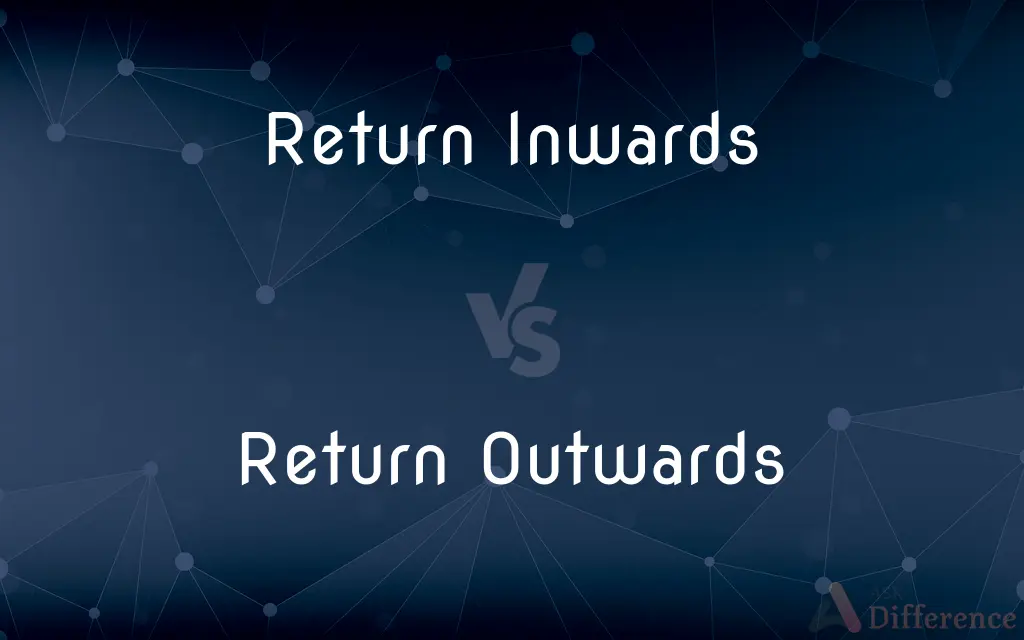Return Inwards vs. Return Outwards — What's the Difference?
By Tayyaba Rehman — Published on October 6, 2023
Return Inwards refers to goods returned to a business by customers; Return Outwards denotes goods returned by the business to its suppliers. Both impact financial accounts differently.

Difference Between Return Inwards and Return Outwards
Table of Contents
ADVERTISEMENT
Key Differences
Return Inwards and Return Outwards are fundamental concepts in accounting, impacting the financial structure of businesses in diverse ways. Return Inwards, also known as sales returns, refers to goods that customers return to the selling business, usually due to defects, inaccuracies, or dissatisfaction. This process reduces the business's sales revenue as it essentially represents a reversal of sales transactions and affects the profitability and liquidity of the business, requiring meticulous accounting and management.
Conversely, Return Outwards, or purchase returns, signifies goods that the business returns to its suppliers, usually due to similar reasons like defects or inaccuracies. This process reduces the business’s cost of goods sold (COGS) and represents a reversal of purchase transactions. The effective management and documentation of Return Outwards are crucial for maintaining supplier relationships, accurate inventory levels, and financial integrity, mitigating potential disputes and discrepancies.
In the context of financial reporting and analysis, the proper recording and assessment of Return Inwards are critical. It necessitates accurate adjustments to the sales revenue, accounts receivable, and inventory, reflecting the true financial position and performance of the business. This not only ensures compliance with accounting standards but also aids in business planning, decision-making, and risk management, providing insights into customer satisfaction and product quality.
Return Outwards, on the other hand, requires precise adjustments to the purchases, accounts payable, and inventory in financial statements. Proper management of Return Outwards is vital for achieving accurate financial reporting and analysis, ensuring accountability, compliance, and strategic alignment. It provides insights into procurement efficiency, product quality, and supplier performance, aiding in supplier negotiations, inventory management, and strategic procurement.
Managing both Return Inwards and Return Outwards effectively is pivotal for businesses to maintain operational efficiency, financial accuracy, and stakeholder relationships. While Return Inwards focuses on the customer side of the business, reflecting on sales strategies and customer satisfaction, Return Outwards revolves around supplier interactions, impacting procurement strategies and inventory management, each contributing significantly to the overall sustainability and success of the business.
ADVERTISEMENT
Comparison Chart
Definition
Goods returned to the business by customers.
Goods that a business returns to its suppliers.
Impact on Financials
Reduces sales revenue.
Reduces cost of goods sold (COGS).
Management Importance
Crucial for maintaining customer satisfaction and accurate financial reporting.
Essential for maintaining supplier relationships and inventory accuracy.
Accounting Adjustments
Affects sales revenue, accounts receivable, and inventory.
Influences purchases, accounts payable, and inventory.
Insights Provided
Offers insights into customer satisfaction and product quality.
Provides perspectives on supplier performance and procurement efficiency.
Compare with Definitions
Return Inwards
Return Inwards reduces the business's sales revenue.
Accurate recording of Return Inwards is vital for reflecting the true financial position of the business.
Return Outwards
Return Outwards represents a reversal of purchase transactions.
Return Outwards necessitates adjustments in purchases, accounts payable, and inventory in the financial statements.
Return Inwards
Return Inwards impacts the profitability and liquidity of a business.
A high volume of Return Inwards may indicate issues with product quality or customer satisfaction, affecting profitability.
Return Outwards
Outwards signifies goods that the business returns to its suppliers.
Proper documentation of Return Outwards is essential for maintaining accurate inventory levels and supplier relationships.
Return Inwards
Return Inwards requires meticulous accounting and management.
Proper management of Return Inwards ensures compliance with accounting standards and aids in business planning.
Return Outwards
Return Outwards is crucial for maintaining financial integrity and supplier relations.
Proper handling of Return Outwards mitigates potential disputes with suppliers and ensures financial integrity.
Return Inwards
Return Inwards represents a reversal of sales transactions.
Return Inwards necessitates adjustments in sales revenue, accounts receivable, and inventory in financial statements.
Return Outwards
Return Outwards reduces the cost of goods sold (COGS).
Recording Return Outwards accurately is critical for achieving correct financial reporting and analysis.
Return Inwards
Return Inwards are goods returned by customers to the selling business.
Managing Return Inwards effectively is crucial for maintaining customer relationships and accurate sales records.
Return Outwards
Return Outwards impacts procurement strategies and inventory management.
Efficient management of Return Outwards provides insights into procurement efficiency and supplier performance.
Common Curiosities
What is Return Inwards?
Return Inwards refers to goods returned by customers to the selling business due to defects or dissatisfaction.
What is the impact of Return Outwards on financial statements?
Return Outwards reduces the cost of goods sold (COGS) and requires adjustments in purchases, accounts payable, and inventory.
Why is managing Return Outwards important?
Managing Return Outwards is crucial for maintaining supplier relationships, accurate inventory levels, and ensuring accurate financial reporting.
Can Return Outwards impact supplier relationships?
Yes, improper management of Return Outwards can lead to disputes and strain relationships with suppliers.
How does Return Inwards affect a business’s revenue?
Return Inwards reduces the business’s sales revenue as it represents a reversal of sales transactions.
How is Return Inwards recorded in accounting?
It is recorded by making adjustments to sales revenue, accounts receivable, and inventory in the financial statements.
Share Your Discovery

Previous Comparison
Merchant Banking vs. Wholesale Banking
Next Comparison
Ancestry vs. ParentageAuthor Spotlight
Written by
Tayyaba RehmanTayyaba Rehman is a distinguished writer, currently serving as a primary contributor to askdifference.com. As a researcher in semantics and etymology, Tayyaba's passion for the complexity of languages and their distinctions has found a perfect home on the platform. Tayyaba delves into the intricacies of language, distinguishing between commonly confused words and phrases, thereby providing clarity for readers worldwide.











































